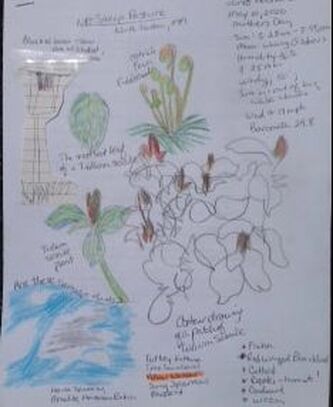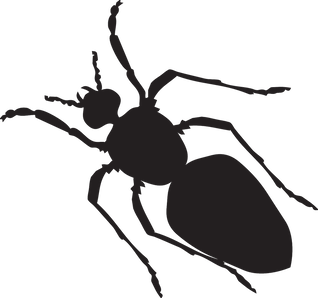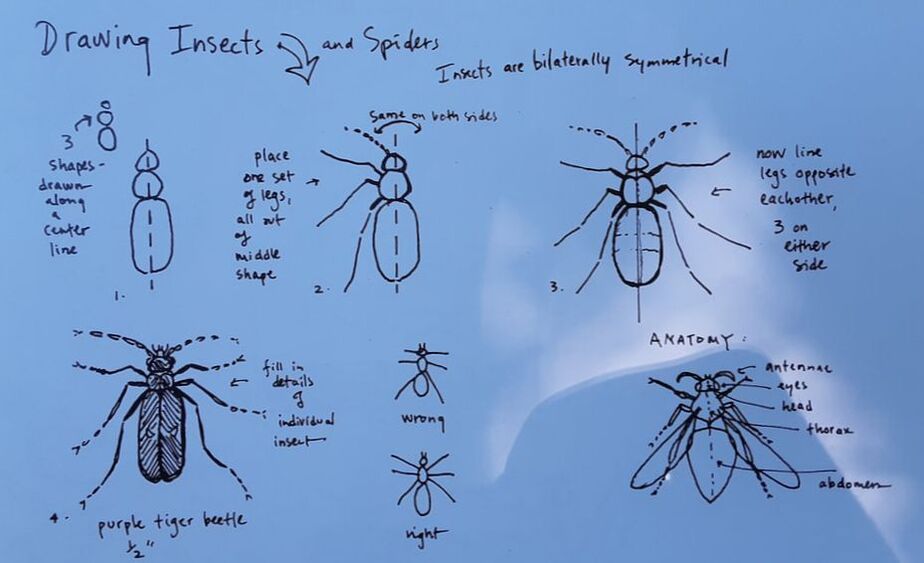|
Another day, another opportunity to get outside and get journaling! Over the past two weeks we’ve talked about different ways to track changes in the season and embrace the month of May! It is the perfect time of year to get outside and see what lives near and around our homes as animals and plants prepare for the summer months. Thank you to everyone who has been sharing your nature journaling journey with us, it is incredible to see all the wildlife you’ve been able to explore. Below are some great examples of what community members have been observing during the exciting month of May. On the left, Janet Bednarz documents a cluster of Toad Trillium and Ostrich Fern Fiddleheads at the NRT! This is a wonderful example of how creating a contour drawing can help to capture the shape and essence of a subject before adding details such as texture and color. On the right is a popping depiction of the different stages of blossoms from one single branch on a local shrub. Thank you for sharing! This week we are going to focus on something that isn’t always obvious when we step outside – the insects in our lives! It may be hard to believe, but insects are the most diverse group of animals on this planet and there are over 900,000 documented species of insects around the world. It is predicted that at any given moment, there are more than one quintillion six legged critters wandering this planet at once and for every pound of human weight that is on earth, there are 300 pounds of insect weight! For anyone wondering, a quintillion looks like this: 1,000,000,000,000,000,000! You’re probably thinking, if that were the case, wouldn’t we have to be constantly surrounded by insects? Well, we are! Because of their small size, ability to move quickly, and excellent camouflage skills, insects are tricky to spot but they really are everywhere! This week’s task is all about finding some six-legged invertebrates and getting to know them through journaling. Some Basics Not all of the small, scuttling macroinvertebrates wandering around are insects. There are some key characteristics that distinguish insects from other bug groups. Two of the major things you can look for when trying to identify an insect are: Try to find some small, crawly critters near you and figure out if they are in fact insects, or possibly something else! When it comes to journaling about insects, there are many different approaches you can take. One way to start finding insects near you is to open your ears. Many insects make distinct sounds by rubbing different parts of their bodies together. Think crickets, grasshoppers, and cicadas. You can follow these sounds to try and find exactly who is making what noise. It may be helpful to have an insect guide on hand, so that you know what to look for and where these insects are most likely to be found. Once you are ready to draw your insect, you only really have to draw half of them! Insects are bilaterally symmetrical, which means that the right side of their body and the left side of their body is exactly the same. For drawing purposes this means that you only have to focus on half of the insect while it is in front of you and then you can recreate the other half as a mirror image at your leisure. Below is a great example of the steps you can take when drawing an insect from Clare Walker-Leslie and Charles E. Roth’s Keeping A Nature Journal. This week, challenge yourself to go on a bug hunt (idea taken from Clare Walker Leslie’s The Nature Connection). Head out to your backyard, or a local green space and see what you can find! Once you’ve caught your insects, you can sketch them, make note of how large they are, notice what their eyes look like, observe if they have wings or antennae, and take note of anything else you see! After you’ve gotten everything you can from them, be sure to put your insects right back where you found them. This activity can be done without catching any insects and simply by observing them in their natural habitat – whatever works best for you!
Good luck finding some interesting insects and as always if you have any observations or journal entries you’d like to share with us, please email them to [email protected]. Happy nature journaling!
0 Comments
Leave a Reply. |
AuthorNRT's dedicated staff are responsible for the content of the NatureTalk blog. Questions? For more information on any blog post, please contact us at any time. Archives
December 2021
Categories
All
|








 RSS Feed
RSS Feed
